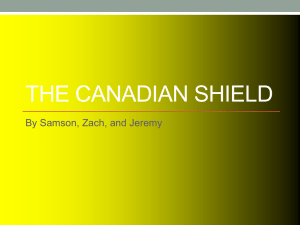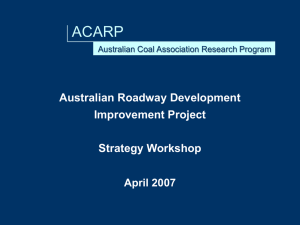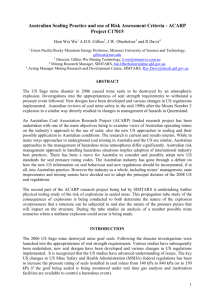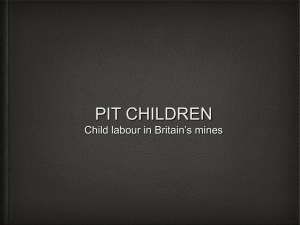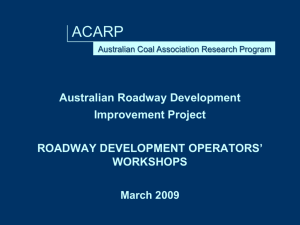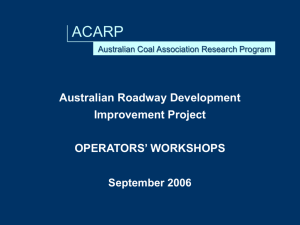Australian Sealing Practice and use of Risk Assessment Criteria
advertisement
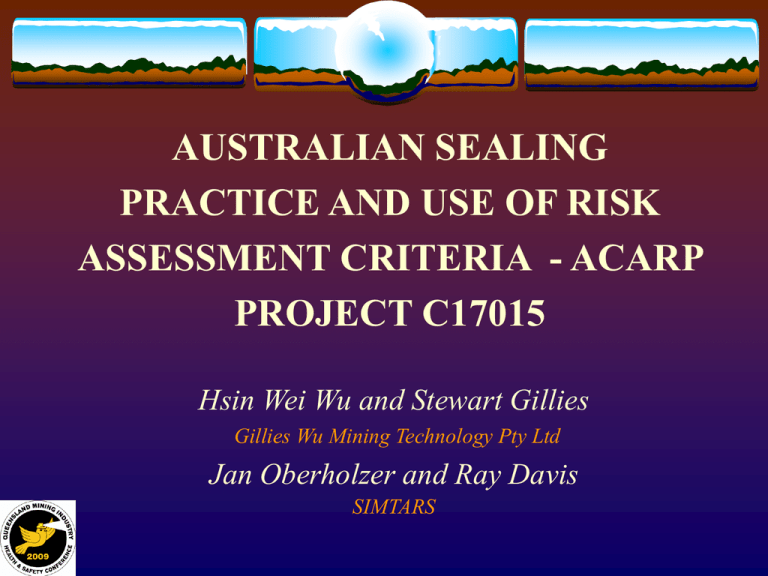
AUSTRALIAN SEALING PRACTICE AND USE OF RISK ASSESSMENT CRITERIA - ACARP PROJECT C17015 Hsin Wei Wu and Stewart Gillies Gillies Wu Mining Technology Pty Ltd Jan Oberholzer and Ray Davis SIMTARS AIM Objective of the project to examine the new US approaches to sealing. The assessment will point out how Australian approaches and practices differs significantly from those in the US. The project is ACARP funded on a grant to SIMTARS and GWMT. A mine survey has been completed to understand current Australian attitudes to sealing and to allow the current normal standards to be maintained while ensuring safety standards equal to those being adopted in the US. Work ha been undertaken to determine the risk of explosions in the sealed off areas through tests conducted in a propagation tube. The work is focused to determine the nature of the explosion overpressures that a structure can be subjected to and the nature of the pressure pulses that will impact on the structure. ACARP C17025 Relevant US Differences with Australian Mines In US LW Gate road 3 Headings are customary (long explosion run up distances) In US lower take up of electronic monitoring In US no use of Tube bundles system In US little use of inertisation In US lack of ventilation network programs usage In US lack of trained VOs In US thinner seams, less coal in goaf In US Seals on Mains; generally not along chain pillars ACARP C17025 US longwall mining - normal district and panel sealing ACARP C17025 Australian LW with crosscut seals and bleeder roads ACARP C17025 Australian LW with crosscut seals but no bleeder roads ACARP C17025 Relevant US Differences with Australian Mines In US very many changes occurring now (like Australia in mid to late 1990s) In US lack of trust between managers and inspectors US Industry is diverse; lack of available data In US less sharing and industry forums In US many small operations In US prescriptive regulations In US lower acceptance of risk assessment approaches ACARP C17025 Mine Survey – General Info A total of 14 mines were visited and surveyed, seven each in NSW & QLD. 13 mines longwall and one room and pillar. Most surveys were conducted with mine Ventilation Officers. Additional input from senior mining engineers, geotechnical engineer, technical service managers or mine managers. Of the 13 LW mines, five mines have ROM production of >4 mtpa, three mines have 3-4 mtpa, two mines have 2-3 mtpa and rest (3) have < 2 mtpa. Production from the 13 LW mines represents about 46% (43 mt) of total Australian longwall production of 92 mt in 2007. ACARP C17025 Summary on Mine Survey All mines receptive and positive. Goaf management is proactive; use of risk assessment Good understanding of sealing purpose – separate atmospheres either side of structure Good understanding of diurnal changes, pressure effects and seal limitations Good understanding of geomechanics structural member – the roof, ribs, floor and seal Goaf atmospheres complex and changing; some move in and out of explosibility ranges ACARP C17025 Sealed Goaf atmospheric gas concentrations after goaf has been sealed for some time and reached mature phase. Readings from tube bundle systems sampling through Mains seals. % CH4 % CO2 % O2 ~3 3 neg 55 unknown neg 80-85 unknown unknown ~70 unknown unknown 75.6 9.31 0.04 70 - 90 3 2-1 10 - 20 30 - 40 <1 >50 unknown 2 20 - 40 <15 1 60.9 5 0.2 >87 <1 <2 <4 12 - 18 >1 <1 <1 >18 unknown unknown unknown ACARP C17025 Mines Survey – Sealed Area Atmosphere Half of mines (7) have some forms of panel bleeder ventilation arrangements to handle seam gas. Five mines have medium or high potential for spon comb and three of them indicated that spon comb had occurred in the past. Nine mines indicated that sealed areas would pass through the explosive range. Seven mines have no need for the use of induced inertisation. The rest (7) of mines surveyed have considered use of induced inertisation with 3 using Tomlinson boiler, 2 using Floxal and the other 2 using seam methane gas. ACARP C17025 Seals Construction Final chain pillar seals providing separation from adjacent panel air No seals, One Room and pillar mine. Eight mines use 140kPa rating. One mine uses 35kPa rating. One mine uses 70kPa rating. Two mines use Nitrogen balance chambers, one seal 35kPa, other seal 140kPa rated. One mine uses Fibro stopping with joints sealed with “silent seal”. No rating. One mine uses Plaster board sprayed with cementitous material > 50mm thick. No rating. ACARP C17025 Seals Construction Final panel seals providing separation from Mains air Five mines use 350kPa rating. Four mines use 140kPa rating. Two mines use 35kPa rating. One mine uses 140kPa, but may move to 350kPa for future and for sealing old areas. Two mines use Nitrogen balance chambers, (one seal 35kPa, other seal rated 140 kPa). ACARP C17025 Other Considerations Almost all mines mentioned that they have had seals that became defective over life Almost all mines recognized that chain pillars crush out leading to atmosphere connectivity All mines have long voids within sealed goafs of longer than 50m ACARP C17025 Australian Survey views on US changing approaches We should stick with what works best for us. Industry should use appropriate risk levels for seal design. 840 kPa (120psi) seals excessive. Consider US move to 840kPa (120psi) is over reaction. Consider US should move to use of gas monitoring and prevention. ACARP C17025 Australian Survey views on US changing approaches Impressions that US is coming from a lower standard to current Australian practices. US appears to have a different approach to the way Australian mines manage the goaf. Primary Australian approach is maintaining inertisation of goaf. US doesn’t have monitoring systems in place. They are guarding themselves from failure rather than adopting an approach of prevention. Australia should not blindly go down the path of copying US. ACARP C17025 SIMTARS Propagation Tube Tests Tests are being conducted in a 30m long (0.5m in dia.) propagation tube not only to determine the nature of the explosion overpressures that a structure can be subjected to, but also the nature of the pressure pulses that will impact on the structure. An analysis of possible scenarios in a mine was made and indicated that there are nine different situations where a methane explosion could occur in a mine. The most probable of these scenarios was high length to diameter ratio roadway that would be full or partially filled with an explosive mixture. ACARP C17025 SIMTARS 30m Propagation Tube Layout ACARP C17025 Explosion Tube Testing Results Tests with three sections filled with gas Maximum total pressure contained was 231kPa Higher total pressure values were obtained when the structures broke with maximum recorded of 430kPa Tests with four sections filled with gas Maximum pressure developed when contained was 265kPa. Higher total pressure values were obtained when the structures broke (maximum recorded was 400kPa) Tests with six sections filled with gas Maximum total pressure developed was 886kPa Maximum static pressure obtained was 418kPa ACARP C17025 Explosion Tube Testing Results (cont) Tests with full nine sections filled with gas The maximum total pressure obtained was 907kPa was at 8.0% CH4 which is slightly less than the stoichiometric concentration of 9.5%. The maximum static pressure of 472kPa was also obtained at this concentration. A repeated 8% CH4 test showed lower pressures. This suggests there may be some variations in the way the gas is presented in the tube and the mixture is probably not completely homogeneous. Further testing is currently continuing. ACARP C17025 Animation of Prop Tube Explosion It presents the pressures obtained at various points along the tube from an 8% methane in air explosion that takes place in 1 second. The tube was completely filled with the gas mixture. The explosion was shut in with a 34mm thick plywood structure. It demonstrates the complex nature of pressure build-up in an elongated vessel. ACARP C17025 Video Clips of Prop Tube Explosion 1 Slow motion video. Internal view from ignition end of tube towards the open end. 2-4 Three slow motion videos. Internal view as before but with closed end. 5 Normal speed video. External view of the open ended tube. 6-7 Two normal speed videos. External view of the closed end. 8 Slow motion of high speed video. This 34mm plywood structure does not fail at this attempt but it does at a subsequent firing. 9 Slow motion of high speed video. The structure failed at the first attempt. ACARP C17025 Conclusions and Further Work Start design from premise we cannot build a perfect seal Seal designs must be determined using priorities from risk assessment of particular situations. Risk levels should meet ALARA (as low as reasonably achievable) with health and safety conditions expectations of less than 1 death per million miner days of work Less than 10 deaths per 10 million miner days of work Never more than 10 miner deaths No explosion detonations ever recorded in mines; only deflagrations ACARP C17025 Conclusions and Further Work (cont) Seal should be rated to “seal” and not on structural applied pressure loading, ie keep goaf gases out of ventilation roadways and keep oxygen out of goafs Mines with low gas levels should not face onerous conditions; One rule not appropriate for all Mines with potentially explosible gases need to monitor, respond and control Good engineering standards for seals needed More understanding of geomechanics needed More understanding of goaf gases ignition potential needed ACARP C17025 Conclusions and Further Work (cont) Initial SIMTARS test findings give more understanding to the complex ways deflagrations can act on structures. Testing to date has resulted in a maximum static pressure of 472kPa. This is well below the explosion pressures expected for a closed volume. No evidence of pressure piling at this stage. The SIMTARS testing is currently continuing. A generic risk assessment for rated seal designs will be developed based on the findings from the mine surveys and SIMTARS tests and will serve as a guide for the Australian mining industry when undertaking their own site specific risk assessments on seals. ACARP C17025 Thank You!

